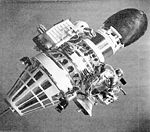- Kosmos 60
-
Kosmos 60 (Russian: Космос 60 meaning Cosmos 60) was an E-6 series probe, launched by the Soviet Union on March 12, 1965. It was the sixth attempt at a lunar soft-landing mission, with a design similar to that of Luna 4. The spacecraft achieved Earth orbit (apogee 287 km, perigee 201 km, inclination 64.8 degrees, orbital period 89 minutes) but failed to leave orbit for its journey to the Moon due to a failure of the power supply in the control system, and was designated Kosmos 60. It had an on-orbit mass of 6530 kg (14,400 lb). The satellite reentered the Earth's atmosphere on 17 March 1965.
Kosmos 60 carried a 16-channel NaI(Tl) scintillator 40 x 40 mm in size. It was surrounded in a charged particle rejection scintillator. The spacecraft weighed 1600 kg and the detector was located inside the vehicle. The detector was sensitive to 0.5-2.0 MeV photons.
Kosmos 60 measured the gamma-ray background flux density to be 1.7×104 quanta/(m2·s). As was seen by Ranger 3 and Lunas 10 & 12, the spectrum fell sharply up to 1.5 MeV and was flat for higher energies. Several peaks were observed in the spectra which were attributed to the inelastic interaction of cosmic protons with the materials in the satellite body.
The designation of this mission as an intended planetary probe is based on evidence from Soviet and non-Soviet sources and historical documents.
References
- This article uses text from The Cosmos series satellites by NASA
Preceded by
Luna 1964BLuna programme Succeeded by
Luna 1965ALuna programme (of the Soviet space program) Luna E-1 No.1 · Luna E-1 No.2 · Luna E-1 No.3 · Luna 1 · Luna E-1A No.1 · Luna 2 · Luna 3 · Luna E-3 No.1 · Luna E-3 No.2 · Luna E-6 No.2 · Luna E-6 No.3 · Luna 4 · Luna E-6 No.6 · Luna E-6 No.5 · Kosmos 60 · Luna E-6 No.8 · Luna 5 · Luna 6 · Luna 7 · Luna 8 · Luna 9 · Kosmos 111 · Luna 10 · Luna 11 · Luna 12 · Luna 13 · Luna E-6LS No.112 · Luna 14 · Luna E-8 No.201 · Luna E-8-5 No.402 · Luna 15 · Kosmos 300 · Kosmos 305 · Luna E-8-5 No.405 · Luna 16 · Luna 17 · Luna 18 · Luna 19 · Luna 20 · Luna 21 · Luna 22 · Luna 23 · Luna E-8-5M No.412 · Luna 24← 1964 · Orbital launches in 1965 · 1966 → Kosmos 52 | OPS 3928 | OPS 7040 | OV1-1 | TIROS-9 | OPS 4703 | Kosmos 53 | OSO-2 | LES-1 | DS-P1-Yu No.2 | Apollo A-103 · Pegasus 1 | Ranger 8 | DS-A1 No.6 | Kosmos 54 · Kosmos 55 · Kosmos 56 | Kosmos 57 | OPS 4782 | Kosmos 58 | Surveyor SD-1 | Kosmos 59 | NRL PL142 · GGSE-2 · GGSE-3 · SECOR-3 · Solrad 7B · Surcal 4 · Dodecapole 1 · Oscar 3 | OPS 7087 · SECOR-2 | Kosmos 60 | OPS 4920 | Kosmos 61 · Kosmos 62 · Kosmos 63 | OPS 7353 | Voskhod 2 | Ranger 9 | Gemini III | Kosmos 64 | OPS 4803 | OPS 4682 · SECOR-4 | Intelsat I F1 | Luna E-6 No.8 | Kosmos 65 | Molniya 1-01 | OPS 4983 · OPS 6717 | Explorer 27 | OPS 5023 | LES-2 · LCS-1 | Kosmos 66 | Luna 5 | OPS 8431 | OPS 8386 | Apollo A-104 · Pegasus 2 | Kosmos 67 | OPS 5236 | OV1-3 | Explorer 28 | Gemini IV | Luna 6 | OPS 8425 | Kosmos 68 | Titan 3C-7 | OPS 8480 | Kosmos 69 | OPS 5501 · OPS 6749 | TIROS-10 | Kosmos 70 | OPS 5810 | Zenit-2 No.28 | Kosmos 71 · Kosmos 72 · Kosmos 73 · Kosmos 74 · Kosmos 75 | Proton 1 | OPS 8411 | Zond 3 | OPS 5543 | OPS 6577 · OPS 6564 · ERS-17 | Kosmos 76 | Apollo A-105 · Pegasus 3 | Kosmos 77 | OPS 5698 · OPS 6761 | SEV · SECOR-5 | Surveyor SD-2 | OPS 8464 · Dodecapole 2 · Tempsat-1 · Long Rod · Calsphere 4A · Surcal 5 | Kosmos 78 | OPS 7208 | Gemini V (REP) | Kosmos 79 | OSO-C | OPS 3373 | Kosmos 80 · Kosmos 81 · Kosmos 82 · Kosmos 83 · Kosmos 84 | Kosmos 85 | OPS 8068 | Kosmos 86 · Kosmos 87 · Kosmos 88 · Kosmos 89 · Kosmos 90 | OPS 7221 | Kosmos 91 | OPS 7208 | Luna 7 | OV1-2 | OPS 5325 | OGO-2 | Molniya 1-02 | OV2-1 · LCS-2 | Kosmos 92 | Kosmos 93 | GATV 5002 | Kosmos 94 | OPS 2155 | Proton 2 | Kosmos 95 | Explorer 29 | OPS 8293 · OPS 6232 | Venera 2 | Venera 3 | Solrad 8 | Kosmos 96 | Kosmos 97 | Astérix | Kosmos 98 | Alouette 2 · Explorer 31 | Luna 8 | Gemini VII | FR-1 | OPS 7249 | Kosmos 99 | Gemini VIA | Pioneer 6 | Kosmos 100 | Kosmos 101 | OV2-3 · LES-3 · LES-4 · Oscar 4 | OPS 1509 | OPS 4639 | Kosmos 102 | Kosmos 103 | DS-K-40 No.1Payloads are separated by bullets ( · ), launches by pipes ( | ). Manned flights are indicated in bold text. Uncatalogued launch failures are listed in italics. Payloads deployed from other spacecraft are denoted in brackets. Categories:- Kosmos satellites
- Luna programme
- 1965 in spaceflight
- Soviet Union spacecraft stubs
Wikimedia Foundation. 2010.


